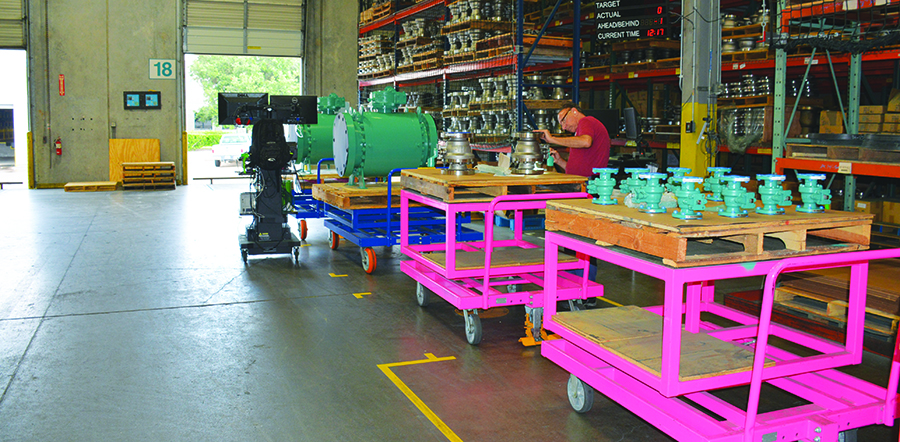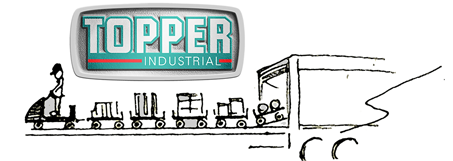Here’s how one global oilfield service and equipment company replaced its forklifts with carts to achieve major efficiency gains and cost savings while also improving worker safety, engagement and ergonomics.

Published October 14, 2019 in Modern Materials Handling. Authored by Bridget McCrea. Find original article HERE.
Last year, Forum Energy Technologies’ Stafford, Texas, production plant was getting close to running out of capacity. Part of a global oilfield service and equipment company, the plant makes a variety of valves across seven different brands. Of particular concern was the plant’s PBV ball valve production area, which produces trunnion-mounted, quarter-turn ball valves in sizes ranging from 3/4-inch to 36 inches.
Open since 1999, the plant revolved around a traditional manufacturing mindset, where a forklift is used to bring parts to one worker, who proceeds to build all of the necessary items for the valve. Then, a forklift comes back to move the completed ball valve to the next stage. But, that setup didn’t work so well when the plant’s business increased significantly.
“When business increased, we knew that we needed to improve the product flow in our plant by eliminating waste and reducing cycle times,” says David Tummins, plant manager. “We knew that would help us build and finish valves faster than we were doing with the traditional setup.”
Bring in the lean
Tummins joined Forum Energy Technologies about two years ago and began to attack the biggest problem, which was a lack of capacity in the facility’s existing layout. Several other issues were also on this lean manufacturing team’s “to do” list. Safety, ergonomics, productivity and performance topped that agenda.
To address these issues, Tummins and his team asked themselves what the PBV production plant would look like five years from now and how that vision fit with its current factory setup. “Moving to a larger location was one option, but that’s a huge expense,” says Tummins. “Instead, we stepped back and looked at how we might be able to put in a system that would enable the flow of product out the back door faster than what we were doing.”
Shopping around
Two years ago, Forum Energy Technologies took about seven days to build a standard ball valve from start to finish. The valve assembly process incorporated 15 different forklift handle points and six different ergonomic points. Where smaller items like floating ball valves weigh about 15 pounds, larger products like 36-inch ball valves weigh upward of 40,000 pounds each.
“Obviously, you can’t move those heavy products very easily, so that’s where we started brainstorming potential improvements,” says Tummins. “We focused on how to turn a job-shop project that was handled by a single operator into a more efficient, production-line type environment.”
As part of that initiative, which kicked off in May of 2018, Forum Energy Technologies focused on cutting down its use of forklifts and instead using carts that could be easily transported to and from its employees’ workstations throughout the course of the day. It also considered conveyors, but after several simulation exercises realized that rotating carts would be the best choice for its manufacturing environment.
 Frank Garcia, the flow master, inspects a job of valves before shipping. The finals process has two different types of carts for the various sizes of valves that flow through the area.
Frank Garcia, the flow master, inspects a job of valves before shipping. The finals process has two different types of carts for the various sizes of valves that flow through the area.
Making the switch
Forum Energy Technologies’ transition to using carts over forklifts started with a trip to a Milwaukee plant where a team of employees worked with a cart manufacturer (Topper Industrial) to come up with five different prototype designs. Starting with a design that could handle a valve that weighed up to 10,000 pounds, they wanted a cart that could move the heavy item without using a forklift. “Operators needed to either be able to push it by hand or use a pusher,” says Tummins, “but not a forklift.”
The company also needed a variety of cart sizes and heights to handle its three main production lines. “Operators needed to be able to work at an ergonomic height, regardless of the job size,” says Tummins. The carts were also designed with rotating tops, which would allow the operator to “spin” the valve (using a foot release) into the right position versus having to walk around it.
With these “must haves” factored into the cart design, Tummins got approval for the project and the rest, as they say, is history. The carts started arriving on site in January 2019, at which point the company began phasing out its use of forklifts on the plant floor.
As part of that transition, the company also switched over from a “production push” system and over to one that’s focused on “production pull,” says Jon Cygan, a lean engineer who joined Forum Energy Technologies in November 2018. To make that happen, it implemented lean manufacturing strategies that, rather than being focused on large batch, non-value-added work processes, uses a one-piece-flow high-value-added assembly line process.
“We’re no longer creating huge batches and are instead working toward a one-piece flow,” Cygan says. “On the very first deployment of this new process, we eliminated significant work-in-process [WIP] inventory.” Working their way through the plant’s various departments, Tummins and Cygan created “material flow” lanes that effectively reduced batch sizes and whittled WIP down by 50%. “We got there by implementing carts and changing the material flow,” says Cygan, who adds that overall production lead times have been reduced to three and a half to four days (from a previous seven days), depending on the type of valve being produced.
“We’re talking about a nearly 40% reduction in lead time from job release to a finished valve, not to mention the fact that we’ve reduced our batch sizes,” says Cygan, “thus eliminating waste and saving a lot of money for the company.”
Once a job is “rolled” to an operator’s work area, it can be worked on immediately without the need for any heavy lifting or maneuvering. Tools are located on the left-hand side of the cart, that—upon completion of the valve—can be pushed into the testing cube without a forklift. “Where the valves once made a half-mile trek on the plant floor during production,” says Tummins, “they now move about 600 feet.”
Major productivity gains
To date, Forum Energy Technologies has removed about 90% of the forklifts that were previously moving around the plant’s open floor area. Those 15 handle points that went into making a single valve have been reduced to just two, and the trunnion-mounted ball valve capacity has grown by 75% (across two shifts). The company has bumped production on its floating ball valve line by 50% a shift.
Now using just 75% of its existing floor space—something it was previously running out of—the manufacturer isn’t resting on its “lean” laurels. As a direct result of this initiative, Forum consolidated another valve assembly plant into the PBV facility, generating significant incremental savings. According to Tummins, in 2020 Forum plans to take its carts over to the distribution center, where activities will be rearranged into a format that resembles the pit lane on an auto racetrack.
“In our DC right now, we have 14 different industrial forklifts operating,” says Tummins. “We want to reduce that by at least 60%. That way, when items get picked, they can be put on carts and create a nice flow-through to the customer’s truck.”
 Pictured front to back: Fredy Victoria and Davis Nguyen, testing operators, show how valves are delivered to the two-bin test machine queues with assembly carts.
Pictured front to back: Fredy Victoria and Davis Nguyen, testing operators, show how valves are delivered to the two-bin test machine queues with assembly carts.
The hidden “wins”
Forum Energy Technologies’ cart initiative has also led to a number of undiscovered “wins” that don’t translate into hard numbers or dollars and cents. According to Cygan, those rewards include morale improvement, better employee engagement, and various other cultural shifts. “When you give employees different tools that help them do their job more efficiently and effectively,” says Cygan, “they not only go home happier, but they also come back engaged and ready to take part in even more improvement activities.”
Importantly, the lean success benefits customers by allowing a more direct line of sight to their needs. Significant reduction in cycle time allows Forum to deliver products when needed by the customer. The lean assembly process, in conjunction with the fact that Forum is one of few domestic valve manufacturers, provides a powerful combination for customers.
 2500 class stainless steel valve on a transport cart. The cart is pushed using the heavy-duty Cart Daddy so operators can easily transport the valve to each operation
2500 class stainless steel valve on a transport cart. The cart is pushed using the heavy-duty Cart Daddy so operators can easily transport the valve to each operation
Finally, the company also eliminated the top-three safety hazards in its production area, which were: forklift traffic, pressure testing and lifting/rigging. With no forklift traffic to worry about, it also redesigned its pressure-testing process to eradicate potential safety hazards. And, operators no longer have to physically manipulate heavy valves; they just let the rotating carts handle that work.
“We engineered out all three of our biggest safety risks,” says Cygan. “So, not only was this project great in terms of creating major efficiencies and cost reductions, but our operators are also safer now.”

